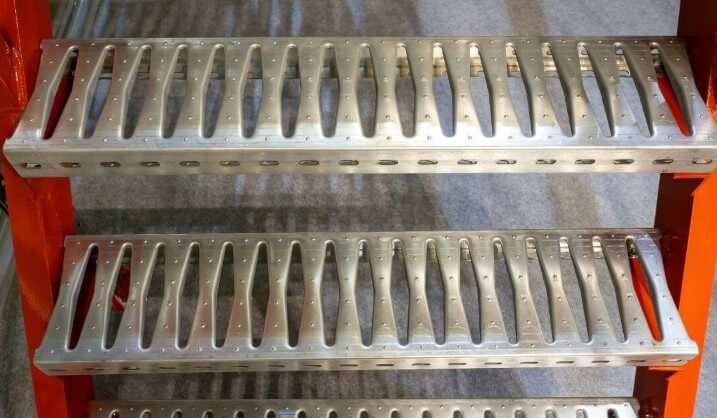

To create a secure, accident-free work environment, implement safety measures in warehouse mezzanines. In this section, we will explore valuable guidelines that will increase workplace safety, protect workers, and uphold the integrity of the mezzanine structure.
Every mezzanine should include robust guardrails and fall protection systems to prevent accidents and improve the safety of workers. A three-rail system—which includes a top rail, mid-rail, and toe board—is a standard, essential feature for preventing falls and providing a secure barrier.
The top rail is the primary source of protection, the mid-rail adds an extra safety feature, and the toe board prevents tools or materials from falling off the platform. Guardrails should consist of durable materials, be able to withstand significant impact, and easily secure to the mezzanine deck.
Additionally, warehouses should implement safety gates in areas requiring frequent access to goods or equipment—such as loading zones and entry points—to provide extra protection without hindering accessibility. For high-risk tasks like loading or unloading materials, provide proper fall protection equipment, including harnesses, lanyards, and safety nets.
Regular inspections and maintenance of all safety systems are crucial to comply with workplace safety standards. Implementing these measures will develop a secure working environment with decreased risks of injury.
Adhering to load capacity limits is a fundamental safety measure in mezzanine operations and crucial for maintaining a secure working environment. Each mezzanine can withstand a specific maximum weight. Exceeding the weight limit can compromise the mezzanine’s structural integrity, potentially leading to costly damage or hazardous situations.
To prevent overloading, display weight limits in visible areas, including entry points and load-bearing zones. Regularly communicate the load limits to the team during safety briefings or training sessions.
Warehouse managers should take a proactive role in enforcing compliance by closely monitoring the amount and type of load placed on mezzanine surfaces. Prevent undue stress on the structure by evenly distributing weight to avoid overburdening specific areas. Pay attention to areas near edges or corners; these zones are more vulnerable to excessive weight.
Compliance with local building hazard codes maintains the mezzanine’s safety. Most regions have specific regulations governing mezzanine construction, modifications, and usage. Familiarize yourself with building codes that apply to your warehouse and closely follow the rules during installation and operation.
Review these codes regularly; regulations often change to address emerging safety standards. Additionally, ensure the mezzanine meets Occupational Safety and Health Administration (OSHA) requirements to avoid penalties and guarantee worker safety.
Stairways and access points to mezzanines should remain clear and unobstructed at all times. Accumulated clutter around stairs increases the risk of trips and falls, creating unnecessary hazards for employees. Assign regular inspections to keep areas free of misplaced equipment, boxes, or debris.
Additionally, install anti-slip treads on stairs to provide sufficient grip, especially in damp or dusty conditions. Clear signage and marked pathways leading to mezzanine stair entrances improve visibility and ensure compliance with safety protocols.
Ongoing maintenance promotes safe mezzanine operation because wear and tear may weaken the mezzanine’s structural components over time. Inspect and address loose bolts, worn decking, and corroded support frames.
Promptly address damage or irregularities detected during maintenance checks. Regular professional assessments can also help identify issues that may not be visible during routine inspections.
All employees working in warehouses with mezzanines should receive thorough training on safe usage practices. The training should cover topics including weight limits, proper loading and unloading methods, and emergency procedures. Managers should also teach employees to properly use safety equipment such as harnesses and gates.
Offering refresher courses reinforces these best practices so all staff members can work safely. Educated employees will greatly mitigate the risks of preventable accidents in the warehouse.
Insufficient lighting around mezzanines creates unnecessary hazards for employees. Poor visibility can cause missteps, collisions, and difficulty navigating stairways.
Lighting on mezzanines should illuminate all working surfaces, access points, and stairways. Use LED fixtures or high-intensity lights to eliminate shadows and cover hard-to-see corners. Workplaces must install emergency lighting to guarantee the staff can safely evacuate or access mezzanines during power outages.
Emergency preparedness is another component of mezzanine safety. Create and prominently display emergency response guidelines according to mezzanine operations. These should include instructions for evacuating the mezzanine in case of fire, structural instability, and other emergencies.
Ensure employees know where to access fire extinguishers, first aid kits, and emergency exits. Conduct regular drills to familiarize staff with the appropriate actions to take during hazardous situations.

